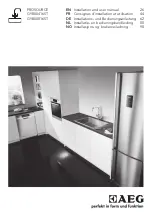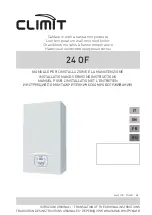
Atmos
Heating Systems
Installation and user manual EN_FMT
18
Pre-adjustment to be done in voltage-free condition:
-
LPG
GAS
– Turn venturi-screw clockwise
3
completely down on its seat.
Then turn the venturi screw anti-clockwise
4
for 2 complete turns.
-
N
ATURAL GAS
– Turn venturi-screw clockwise
3
completely down on its seat.
Then turn the venturi screw anti-clockwise
4
for 4 complete turns.
With a vernier callipers the distance between venturi-screw
(1) and the Top of the venturi-stud (1) has to be measured
to find the rough setting of the venturi screw for full load,
and depending of the used gastype.
The exact adjustment of the setting has to be made using
the CO
2
analysing method as described below.
4.8. Gas / Air adjustment ( CO
2
analysing)
The gas control is set in the factory to the type of gas to be
used. This type of gas is stated on the packing and on the
identification plate. To check the setting, you have to make
a flue gas analysis.
Proceed as follows
Remove the measuring cap
from the flue tube.
Fit the measurement probe
of a flue gas analyser (CO
2
meter) in the measurement
opening of the flue tube
canal.
Make sure there is sufficient
heat dissipation through the
heating.
CO
2
setting
At full central
heating load
(P=100%)
At low load
Natural gas
(G20, G25)
8,8-9.4 % CO
2
8,2-8,6 % CO
2
Propane (G31)
9,8 % CO
2
9,2% CO
2
4.8.1. Full load
The burner has to burn at maximum central heating
capacity (Menu setting P=100%).
Activate the chimney sweeper function on full load.
Read the CO
2
value on the
analyser. If the value does
not correspond with the
value in the "CO
2
setting"
table, carefully adjust the
venturi screw (1). Turn the
venturi screw anti-clockwise
to increase the CO
2
value,
clockwise to decrease it.
4.8.2. Low load
Activate the chimney sweeper function on low load
Read the CO
2
value on the
analyser. If the value does
not correspond with the
value in the "CO
2
setting"
table, carefully adjust the
gas control adjusting screw
(2). To do this, temporarily
remove the cap (3) with the
aid of a Torx screwdriver.
Turn the screw anti-clockwise to decrease the CO
2
value
on low load, clockwise to increase it.
At the end of the flue gas analysis, set the central heating
capacity (P) in the menu again to the value that is best
suited for the application.
4.9. Placing the jacket
Place the jacket in the appropriate hooks at the top of
the unit. Let the jacket pivot until it falls over the unit.
Tighten the fastener at the bottom of the jacket.
4.10. Changing over to LPG-gas
First: the venturi adjusting screw fully clockwise until
it blocks.
Fit a flue gas analyser
(CO
2
meter) in the
measurement opening of
the flue tube canal.
4.10.1. Full load on Propane
Set in the menu the capacity “P” to 100%.
Activate the chimney sweeper function on full load.
Unscrew the venturi adjusting screw four full turns anti-
clockwise.
(A guide for the dimension from the top of the screw to the
top of the support is 16.1 mm).
Read the CO
2
value on the flue gas analyser. If the value
does not correspond with the value for propane gas G31
(9,8% CO
2
), carefully adjust the venturi screw until the
correct value is obtained.
If the gas control is already
properly adjusted for natural
gas, then the low load will
not need to be adjusted.
Activate the chimney
sweeper function on low
load.
Check the CO
2
value at
minimum capacity for propane gas G31 (9.2% - 9.5% CO
2
).
If necessary, adjust the gas regulator screw until the
correct value is obtained. Note that this setting is a critical
one.
PRE- ADJUSTMENT MEASUREMENT:
Distance between Venturi-screw (1) and the Top of the
venturi-stud to be about:
12.5 mm for natural gas G25
14.1 mm for natural gas G20
16,5 mm for LPG gas G31















































